Six-Cylinder Motorcycles
Article by Mark Trotta
Both automobile and motorcycle manufacturers have experimented with six-cylinder engines since at least the 1920's. Not only will more cylinders make more power, they run smoother than two, three, or four-cylinder engines.
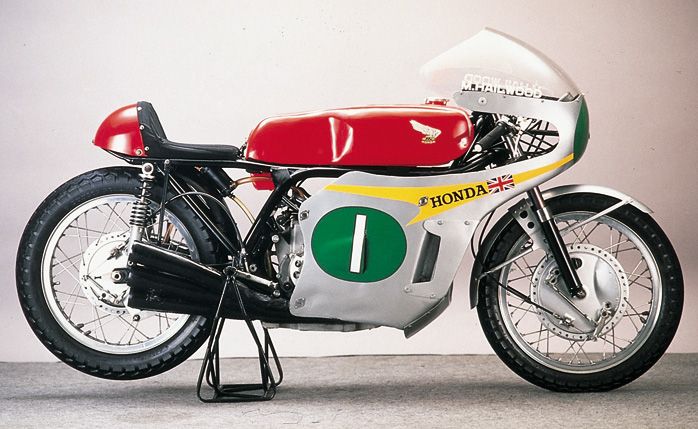
Honda Six-Cylinder RC Race Bike
Purpose-built for Grand Prix racing, Honda produced the first of several six-cylinder motorcycles in 1964. These RC-series bikes sported 24-valves and a 249cc displacement, achieved by a 39mm bore x 34.8mm stroke.
_________________________________________________
_________________________________________________
Honda's RC166, the second of the series, was produced in 1966 and also 249cc, but used a bore and stroke of 41mm and 31mm. The following year saw the 249cc RC167, followed by the 297cc RC174 (41mm x37.5mm) which raced in the 350cc class.
Both the RC166 and RC167 produced around 60 horsepower at 18,000 rpm, allowing top speeds of around 150 mph.
Since Honda RC-series bikes were never offered for sale to the public, they are not considered the first six cylinder motorcycle.
First Production Six-Cylinder Motorcycle
The Benelli 750 Sei (Italian for six) was the first production six-cylinder motorcycle. Displacing 748cc, the engine was based on the Benelli 500cc Quattro, an in-line four with dual overhead cams, chain drive, and a five-speed transmission.
Essentially an inline-four 500cc engine with two extra cylinders, the girth of the inline six was narrowed by moving the alternator off the left side of the motor and mounting it behind the cylinders.
Benelli SEI 750cc
Although completed in 1972, internal issues within the company prevented the SEI (pronounced 'Say') from being released until 1974. At 560 pounds, the bike was heavier than comparable machines, but its solid frame and suspension gave the rider confidence in high-speed cornering.

Adorning both sides of the bike was a trio of chrome mufflers, complimenting the overall lines, as well as showing off it's abundance of cylinders.
With three Dell'Orto carburetors, the Benelli SEI produced around 70 horsepower and was capable of 120 mph. A pair of front disc brakes supplied ample stopping power.
Benelli SEI 900cc
In 1978, the 750cc SEI engine was bored and stroked, increasing displacement to 906cc. 125 mph top-end speeds were now obtainable, and cruising speeds were at lower rpm's.
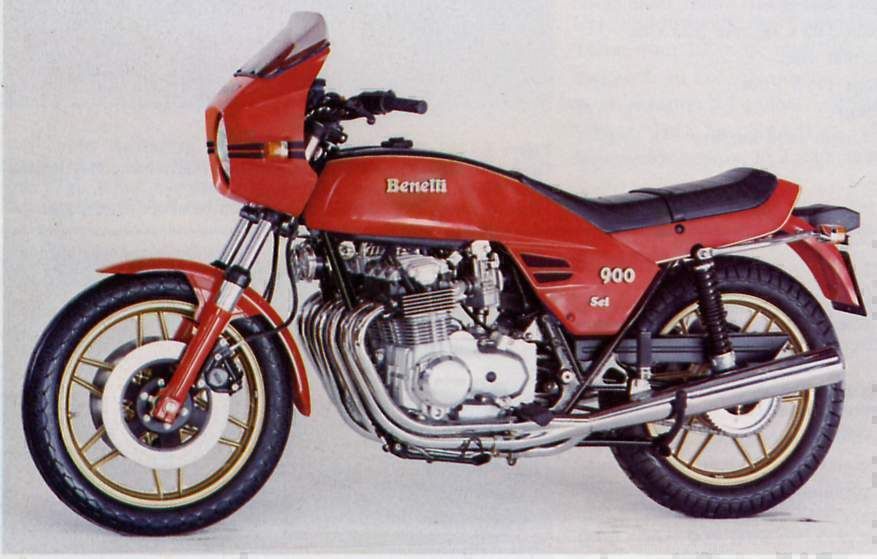
Styling changes included a small, fork-mounted fairing wrapped around the gauges, with the fuel tank now hidden beneath outer panels.
The SEI's spoke wheels were replaced with cast wheels, and a more conventional six-into-two exhaust system replaced the original style. The rear drum brake was replaced by a disc unit.
Kawasaki KZ-1300
Although Benelli had surpassed the Japanese in multi-cylinder bikes, it was only until 1978, when Kawasaki introduced their six-cylinder motorcycle, the KZ-1300. The liquid cooled engine came equipped with a radiator mounted on the down tubes of the frame. Cast wheels front and rear had disc brakes, with two discs up front and one out back.
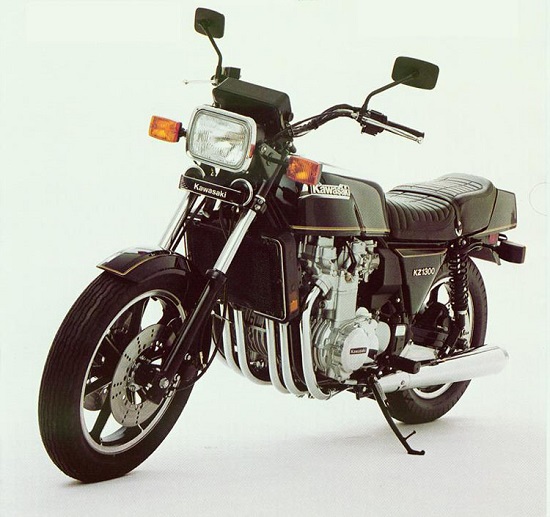
The KZ-1300 was a complex, sophisticated machine.
Using a trio of two-barrel Mikuni 32mm carbs, the dual-cam motor put out 120-horsepower and 85 ft/lb of torque. A driveshaft was used to deliver power to the rear wheel. Weighing over 700 pounds, road tests of the era showed the big Kaw topping 140 mph, with quarter-mile times under 12 seconds.
Honda CBX-1000
The following year, Honda introduced their six-cylinder bike, the twin-cam, 24 valve CBX-1000. Achieving a satisfactory engine width (rider's knee-to-knee) was solved by tilting the engine forward in the chassis 33 degrees, then mounting the carburetors with a V-shaped manifold. By doing this, all six carbs angled in towards the centerline of the motorcycle.
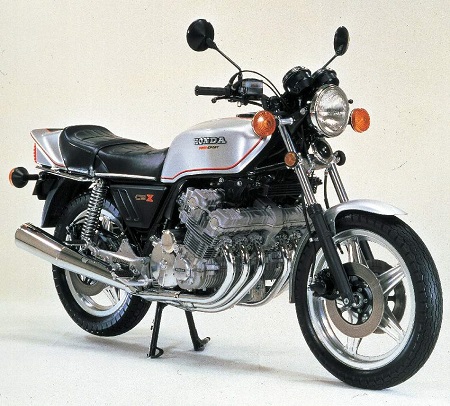
Most modern multi-cylinder motorcycle engines at the time had both alternator and ignition system driven directly off the end of the crankshaft. Given the larger width of the six-cylinder machine, having the alternator and the ignition on the sides would severely hamper the cornering capability of any motorcycle. Honda engineer Shoichiro Irimajiri, designer of both the 250cc and 297cc six-cylinder RC series race engines, solved the issue by utilizing an engine jack-shaft.
_________________________________________________
_________________________________________________
The jack-shaft on the big Honda was turned by a 34mm chain, driven by a sprocket machined in the middle of the crank. One end drives the alternator, the other end times the ignition, as well as the starter motor gear. It also carries power from the crankshaft to the clutch housing, which in turn spins the oil pump through sprockets and chain.
Three ignition coils and a timing rotor sat beneath the outer housing cover, controlled by three black boxes mounted under the seat. Three dual-lead coils were mounted under the fuel tank below the main frame tube. The coils fired cylinders one and six together, three and four together, and two and five together.
The jack-shaft allowed the Honda CBX engine to measure 23.4 inches in width, just two inches wider than the Honda CB750 4-cylinder.
At 600 pounds, the CBX was lighter than the Kawasaki KZ-1300, producing a smooth 105-horsepower, and had recorded 11.36 seconds in the quarter-mile.
Decline And Resurgence
Both the Kawasaki KZ-1300 and the Honda CBX-1000 ended up turning into sport/touring bikes. As more power was coaxed out of four-cylinder engines, the more expensive and complex six-cylinder bikes fell out of favor.
First Six Cylinder Gold Wing
The Honda Gold Wing GL1000, a four-cylinder touring bike, had been doing well in the American market since the early seventies. But by 1984, Honda engineers had began working on a fourth-generation Gold Wing featuring a six-cylinder engine.
Honda Gold Wing GL1500
After several years of research and development, Honda produced the first six-cylinder Gold Wing in 1987, offered for sale as a 1988 model. Three models were offered, the GL1500 Aspencade, GL1500 SE, and GL1500 Interstate.
The bigger motor gave the Gold Wing more horsepower, but also came with more accessories and more weight (794 pounds). Although the new motor still used carburetors, there were now only two, a pair of 36mm CV Keihins.
Honda Valkyrie
In 1997, Honda brought back an incarnation of the standard Gold Wing that was dropped in 1985. The new bike was named Valkyrie. Although based on the GL1500, the new bike had it's own cruiser-style frame.
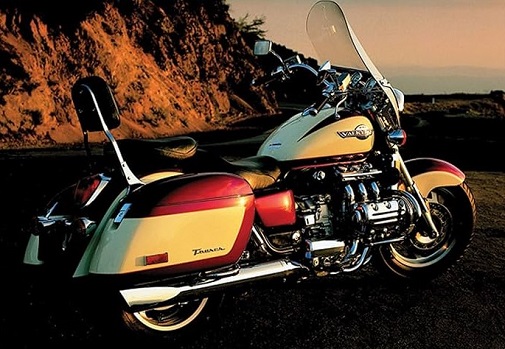
For the Valkyrie, engine performance was enhanced with more aggressive camshafts, free flowing exhaust, solid lifters (versus the Wing's hydraulic lifters), and six carburetors instead of two.
A Limited Edition 1832cc Valkyrie Rune was released in 2004.
Honda Gold Wing GL1800
The Honda GL1800, debuting in 2001, was the first new Gold Wing model in 13 years. Engine displacement increased to 1832cc, with fuel injection replacing the carburetors. By making the frame out of high-strength aluminium, the weight of the bike decreased from that of the GL1500.
First Generation GL1800s were built from 2001-2010. No 2011 model year Gold Wings were produced.
Gold Wing production resumed in 2012 with a new 'second generation' GL1800.
*******************
Related Articles: